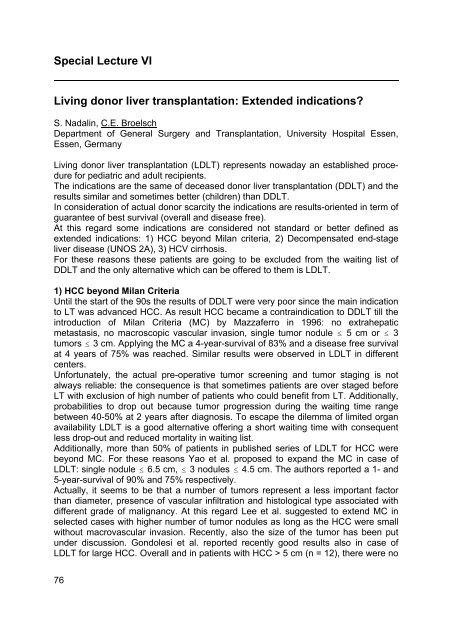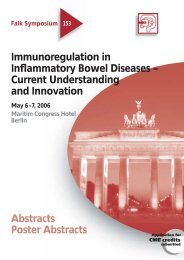Abstracts Poster Abstracts - Dr Falk
Abstracts Poster Abstracts - Dr Falk
Abstracts Poster Abstracts - Dr Falk
You also want an ePaper? Increase the reach of your titles
YUMPU automatically turns print PDFs into web optimized ePapers that Google loves.
Special Lecture VILiving donor liver transplantation: Extended indications?S. Nadalin, C.E. BroelschDepartment of General Surgery and Transplantation, University Hospital Essen,Essen, GermanyLiving donor liver transplantation (LDLT) represents nowaday an established procedurefor pediatric and adult recipients.The indications are the same of deceased donor liver transplantation (DDLT) and theresults similar and sometimes better (children) than DDLT.In consideration of actual donor scarcity the indications are results-oriented in term ofguarantee of best survival (overall and disease free).At this regard some indications are considered not standard or better defined asextended indications: 1) HCC beyond Milan criteria, 2) Decompensated end-stageliver disease (UNOS 2A), 3) HCV cirrhosis.For these reasons these patients are going to be excluded from the waiting list ofDDLT and the only alternative which can be offered to them is LDLT.1) HCC beyond Milan CriteriaUntil the start of the 90s the results of DDLT were very poor since the main indicationto LT was advanced HCC. As result HCC became a contraindication to DDLT till theintroduction of Milan Criteria (MC) by Mazzaferro in 1996: no extrahepaticmetastasis, no macroscopic vascular invasion, single tumor nodule # 5 cm or # 3tumors # 3 cm. Applying the MC a 4-year-survival of 83% and a disease free survivalat 4 years of 75% was reached. Similar results were observed in LDLT in differentcenters.Unfortunately, the actual pre-operative tumor screening and tumor staging is notalways reliable: the consequence is that sometimes patients are over staged beforeLT with exclusion of high number of patients who could benefit from LT. Additionally,probabilities to drop out because tumor progression during the waiting time rangebetween 40-50% at 2 years after diagnosis. To escape the dilemma of limited organavailability LDLT is a good alternative offering a short waiting time with consequentless drop-out and reduced mortality in waiting list.Additionally, more than 50% of patients in published series of LDLT for HCC werebeyond MC. For these reasons Yao et al. proposed to expand the MC in case ofLDLT: single nodule # 6.5 cm, # 3 nodules # 4.5 cm. The authors reported a 1- and5-year-survival of 90% and 75% respectively.Actually, it seems to be that a number of tumors represent a less important factorthan diameter, presence of vascular infiltration and histological type associated withdifferent grade of malignancy. At this regard Lee et al. suggested to extend MC inselected cases with higher number of tumor nodules as long as the HCC were smallwithout macrovascular invasion. Recently, also the size of the tumor has been putunder discussion. Gondolesi et al. reported recently good results also in case ofLDLT for large HCC. Overall and in patients with HCC > 5 cm (n = 12), there were no76



